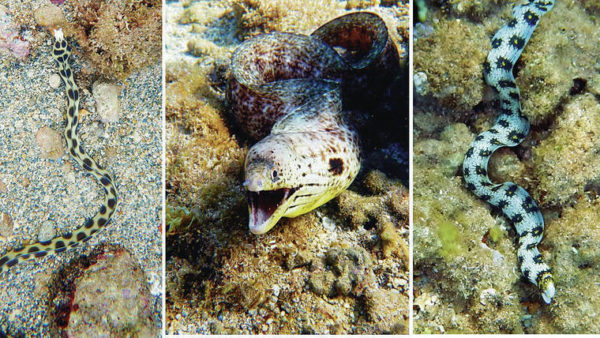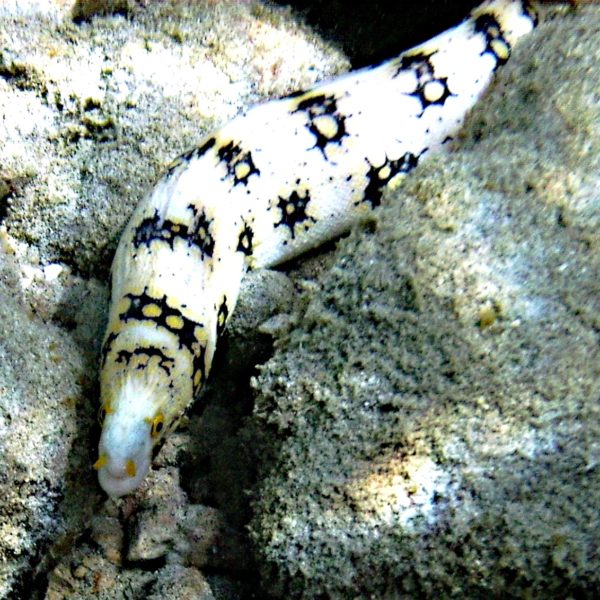Published in the Ocean Watch column, Honolulu Star-Advertiser © Susan Scott
June 15, 2019
On Sunday I went snorkeling at 6:30 a.m., and three Hawaii eel species treated me to a show by, well, showing up. I found the eels, youngsters about a foot long (all three grow to 30 inches) resting on the ocean floor. When I began snapping pictures, each moseyed on, but casually, as if to say, ‘You don’t scare me.’
Nor was I scared of them. Eels have a snakelike shape and, as such, give a lot of people the willies. In addition, lurid stories abound of moray eels biting people, but in most cases either the bite was an accident on the eel’s part or the person deserved it by feeding or poking the eel. In most cases, though, eels are just long, skinny fish that want to be left alone.
The first eel I found was a magnificent snake eel, so called because an early naturalist in 1861 appreciated the beauty of this eel, naming it Myrichthys magnificus, meaning magnificent fish.
 Three young eels — a magnificent snake eel, left,
Three young eels — a magnificent snake eel, left,
Steindachner’s moray and snowflake moray — are seen on the ocean floor.
©2019 Susan Scott
Hawaii hosts at least 17 species of snake eels, but we snorkelers rarely see them because snake eels tend to hide during the day and hunt at night. The magnificent snake eel is the one most often mistaken for a sea snake.
Hawaii hosts no sea snakes but fish predators don’t know that, and given the resemblance, they avoid snake eels. Some human visitors don’t know we lack sea snakes, either, and send me photos of the sea snake they saw. Most often the picture is that of a harmless snake eel.
The eel that appeared to me a minute later was a lovely baby snowflake eel. Although it’s in the same family as moray eels, the snowflake, named after its ornate markings, is different, in that this species has blunt, conelike teeth, all the better to crush crabs, its favorite food. Also, most morays hunt at night, but snowflakes are sometimes out during the day, making them more commonly seen than the other 42 moray species that made their way to Hawaii. Because moray eels’ larvae are exceptionally long-lived, the same species are spread widely through the Indian and Pacific oceans.
Snowflake morays are also special in that they are among the few morays that start life as females and later become males.
The last eel that came out for me doesn’t have a cute name like magnificent or snowflake, but it’s still special, given that it’s a rare endemic species, found only from Oahu to Midway and not usually seen in daylight.
This eel has the easy-to-forget name of Steindachner’s moray, after the Austrian ichthyologist Franz Steindachner (1834-1919). But even though I couldn’t remember its name, the little moray captured my heart by posing for me and then gliding away.
Jumping into the water in the early morning is a bit hard, but with the water calm and some nighttime animals still out, the rewards are well worth it.
 Juvenile Snowflake eel in 2 feet of water at
Juvenile Snowflake eel in 2 feet of water at
Hanauma Bay. In the “rubble zone”.
©2006 Scott R Davis